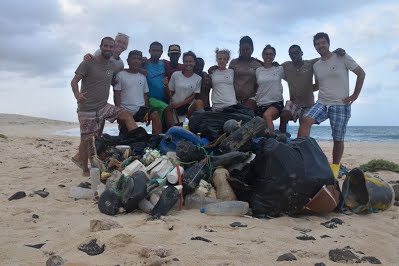Post from Alberto Queiruga
Scientific coordinator at Turtle Foundation.
With another season ending, we have asked Albert Queiruga to reflect a bit on his work with Turtle Foundation. Alberto was the coordinator of the camp where we perform our research. His positive attitude and hard-working nature was of tremendous support for our daily work and we can't thank him enough for this.
Published:

(Season 2017 - Lacacão camp, Boa Vista, Cape Verde)
Another year at the beach, another year protecting and studying this prehistoric species that is the loggerhead turtle. This time I did not do it surrounded by palm trees, living the “Pura Vida”. Instead, I went back to where it all began, to this sunny country in the middle of the Atlantic Ocean, where is located the 3rd largest loggerhead turtle (Caretta caretta) population in the world: Cabo Verde.
My name is Alberto Queiruga, environmental scientist of profession and Spanish of birth. This year, I have been in charge of all the scientific coordination in the research camp of Lacacão (south of Boa Vista island) as part of the “Turtle Foundation” organization. The season balance is completely and entirely positive: we achieved our main goal, i.e. to avoid illegal poaching of nesting females. We ended this season with 0 turtles poached – despite a record in the number of nesting females across all the beaches!
Regarding the research part of the project, >500 hundreds of turtles were individually tagged with internal microchips (PIT Tags) and external identifiers (Metal Tags). Also, several hundreds of them were measured before we collected a small tissue sample, to monitor the population state and learn about this species’ ecology. The Queen Mary University of London research team, led by Chris, was working beside us, doing their own research Project in one of our 5 stars beaches (Ponta Pesqueira).
When it comes to conservation, I must highlight the high number of nests that were relocated from unfavourable locations (mostly because of light pollution) to safer places, or directly to our hatchery. This year, the hatching success exceeded 80% in our hatchery, making it a great conservation tool to produce neonates. Even though the seasonal work is over, thousands of hatchlings are still waiting in the beach for their moment to emerge and try to reach the ocean and maybe, after 20-30 years, visit us again as adults.
I would like to thank all the team, the local people and also the international volunteers for their work and collaboration. It highlights the fact that the conservation of this species, or any other, is not only related to the direct work in the field. All our daily acts can influence in a positive or negative way everything that surrounds us.
Awareness and Respect.
Alberto Queiruga